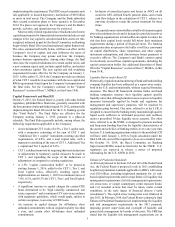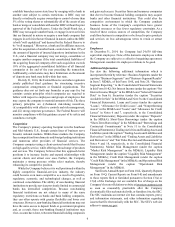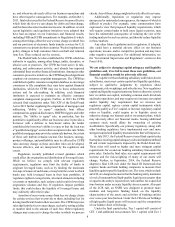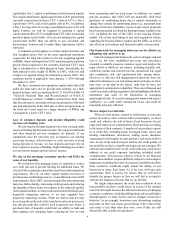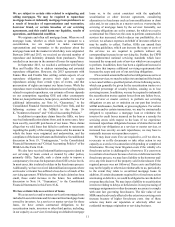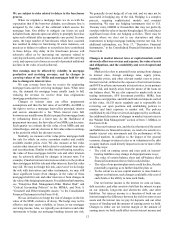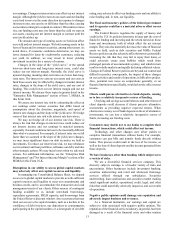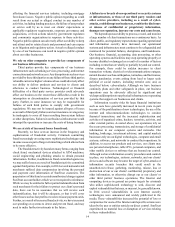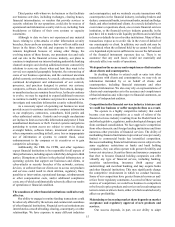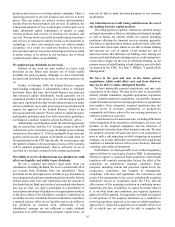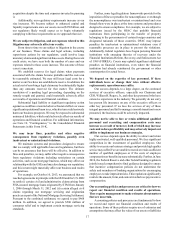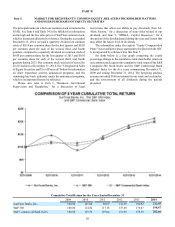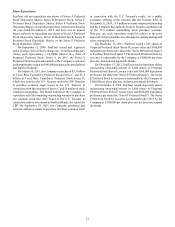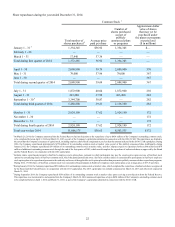SunTrust 2014 Annual Report Download - page 36
Download and view the complete annual report
Please find page 36 of the 2014 SunTrust annual report below. You can navigate through the pages in the report by either clicking on the pages listed below, or by using the keyword search tool below to find specific information within the annual report.13
our earnings. Changes in interest rates can affect our net interest
margin. Although the yield we earn on our assets and our funding
costs tend to move in the same direction in response to changes
in interest rates, one can rise or fall faster than the other, causing
our net interest margin to expand or contract. When interest rates
rise, our funding costs may rise faster than the yield we earn on
our assets, causing our net interest margin to contract until the
asset yield catches up.
The amount and type of earning assets we hold can affect
our yield and net interest margin. We hold earning assets in the
form of loans and investment securities, among other assets. As
noted above, if economic conditions deteriorate, we may see
lower demand for loans by creditworthy customers, reducing
our yield. In addition, we may invest in lower yielding
investment securities for a variety of reasons.
Changes in the slope of the “yield curve,” or the spread
between short-term and long-term interest rates, could also
reduce our net interest margin. Normally, the yield curve is
upward sloping, meaning short-term rates are lower than long-
term rates. The interest we earn on our assets and our costs to
fund those assets may be affected by changes in market interest
rates, changes in the slope of the yield curve, and our cost of
funding. This could lower our net interest margin and our net
interest income. We discuss these topics in greater detail in the
"Enterprise Risk Management" section of Item 7, MD&A, in
this Form 10-K.
We assess our interest rate risk by estimating the effect on
our earnings under various scenarios that differ based on
assumptions about the direction, magnitude, and speed of
interest rate changes and the slope of the yield curve. We hedge
some of that interest rate risk with interest rate derivatives.
We may not hedge all of our interest rate risk. There is
always the risk that changes in interest rates could reduce our
net interest income and our earnings in material amounts,
especially if actual conditions turn out to be materially different
than what we assumed. For example, if interest rates rise or fall
faster than we assumed or the slope of the yield curve changes,
we may incur significant losses on debt securities we hold as
investments. To reduce our interest rate risk, we may rebalance
our investment and loan portfolios, refinance our debt, and take
other strategic actions. We may incur losses when we take such
actions. For additional information, see the “Enterprise Risk
Management” and "Net Interest Income/Margin" sections of the
MD&A in this Form 10-K.
Disruptions in our ability to access global capital markets
may adversely affect our capital resources and liquidity.
In managing our Consolidated Balance Sheet, we depend
on access to global capital markets to provide us with sufficient
capital resources and liquidity to meet our commitments and
business needs, and to accommodate the transaction and cash
management needs of our clients. Other sources of contingent
funding available to us include inter-bank borrowings,
repurchase agreements, FHLB capacity, and borrowings from
the Federal Reserve discount window. Any occurrence that may
limit our access to the capital markets, such as a decline in the
confidence of debt investors, our depositors or counterparties
participating in the capital markets, or a downgrade of our debt
rating, may adversely affect our funding costs and our ability to
raise funding and, in turn, our liquidity.
The fiscal and monetary policies of the federal government
and its agencies could have a material adverse effect on our
earnings.
The Federal Reserve regulates the supply of money and
credit in the U.S. Its policies determine in large part the cost of
funds for lending and investing and the return earned on those
loans and investments, both of which affect the net interest
margin. They can also materially decrease the value of financial
assets we hold, such as debt securities and MSRs. Federal
Reserve policies can also adversely affect borrowers, potentially
increasing the risk that they may fail to repay their loans, or
could adversely create asset bubbles which result from
prolonged periods of accommodative policy, and which in turn
result in volatile markets and rapidly declining collateral values.
Changes in Federal Reserve policies are beyond our control and
difficult to predict; consequently, the impact of these changes
on our activities and results of operations is difficult to predict.
Also, potential new taxes on corporations generally, or on
financial institutions specifically, would adversely affect our net
income.
Clients could pursue alternatives to bank deposits, causing
us to lose a relatively inexpensive source of funding.
Checking and savings account balances and other forms of
client deposits could decrease if clients perceive alternative
investments as providing superior expected returns. When
clients move money out of bank deposits in favor of alternative
investments, we can lose a relatively inexpensive source of
funds, increasing our funding costs.
Consumers may decide not to use banks to complete their
financial transactions, which could affect net income.
Technology and other changes now allow parties to
complete financial transactions without banks. For example,
consumers can pay bills and transfer funds directly without
banks. This process could result in the loss of fee income, as
well as the loss of client deposits and the income generated from
those deposits.
We have businesses other than banking which subject us to
a variety of risks.
We are a diversified financial services company. This
diversity subjects earnings to a broader variety of risks and
uncertainties. Other businesses include investment banking,
securities underwriting and retail and wholesale brokerage
services offered through our subsidiaries. Securities
underwriting, loan syndications and securities market making
entail significant market, operational, credit, legal, and other
risks that could materially adversely impact us and our results
of operations.
Negative public opinion could damage our reputation and
adversely impact business and revenues.
As a financial institution, our earnings and capital are
subject to risks associated with negative public opinion. The
reputation of the financial services industry, in general, has been
damaged as a result of the financial crisis and other matters


